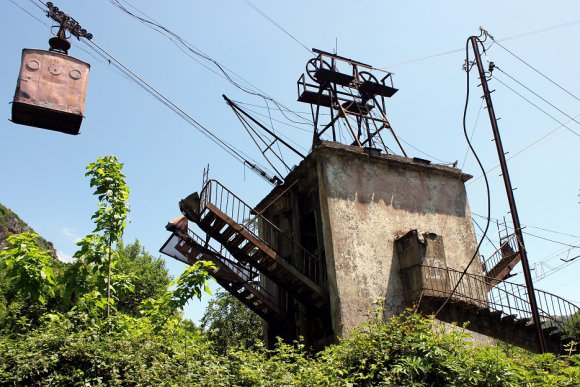Other towns have buses or trams. In Chiatura, in mountainous Georgia, a vast system of cable cars serve public transportation needs, bringing passengers to the neighbourhoods up the slopes. You hit the central rope way station down the valley where cables from three different directions meet. It is the only such station in the world.
This transport system is a testimony of the Soviets’ unique town planning, making Chiatura a place of historical and architectural significance. Yet its legacy has hardly been recognized.
To the visitor, it is thrilling to ride the different types of gondolas serving the many routes and stations, taking in the spectacular views on the way. But the dire state of the ropeways show the system hasn’t been renovated since the 1970s.

- Chiatura, Georgia is a town known for its more than 60 year old vast system of rope ways. They are in a regrettable state due to serious industrial decline after the fall of the Soviet Union. All pictures are © Jens Malling.
Chiatura, originally a prosperous industrial town where people had some of the highest living standards in the Soviet Union, fell into serious decline when the USSR was dismantled in 1991. From one day to the next, the highly developed, modern Soviet Union descended into chaos and poverty, causing terrible living conditions to the populations of its 15 republics, including Georgia.
Taking a closer look from up in the gondola, you get an impression of what this meant for an industrial town like Chiatura.
Surrounded by the lush forest-covered Greater Caucasus mountains, on a sunny day you see large factory ruins, buildings once used for manganese refinement, scattered like murky, rust-coloured shadows. The best, most accessible ore has long been brought up from the pits, but the mountains around Chiatura still have significant deposits. In Soviet times the region was the world’s most important place for extraction of manganese, which was used in the steel industry. The vast ropeway system was not only used for passenger transport. It was also part of the infrastructure, getting the ore from the mines to the processing plants. When the crucial Soviet home market disappeared, the industry was almost wiped out.

- In this abandoned station a sign in Georgian and Russian tells what the working hours of the line used to be.
Much weakened by the new and different conditions of market economy, a few factories struggle on, a long and difficult process of adjustment. The rest of the buildings, dotted around in the beautiful landscape like Greek ruins, recall past glory.
The industrial decline has caused high unemployment, which in turn has caused a severe decline in population: about half of Chiatura’s inhabitants have left since the late 1980s.
But there is good news from Chiatura too: negotiations regarding a planned renovation of the cable car system are taking place. “Members of the Georgian parliament are holding talks with a couple of French firms with the required knowhow. Refurbishment ought to begin within the next two years,” says Mamuka Kenchoshvili, 22, an overseer in Chiatura’s central rope way station.
Whether the much-needed restoration will actually take place depends on foreign grants. The Georgian state is not able to come up with the €6-7 million initially budgeted for the project. “Certain Georgian members of parliament have good connections in the French and Austrian cable car industries. They should be able to negotiate a good solution,” says Kenchoshvili. “Then finally the ropeway system of Chiatura could be brought up to European standards. That’s our dream.”















